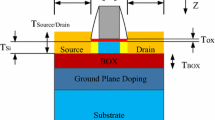Abstract
Since single event transient pulse quenching can reduce the SET (single event transient) pulsewidths effectively, the charge collected by passive device should be maximized in order to minimize the propagated SET. From the perspective of the layout and circuit design, the SET pulsewidths can be greatly inhibited by minimizing the layout spacing and signal propagation delay, which sheds new light on the radiation-hardened ICs (integrated circuits) design. Studies show that the SET pulsewidths of propagation are not in direct proportion to the LET (linear energy transfer) of incident particles, thus the defining of the LET threshold should be noted when SET/SEU (single event upset) occurs for the radiation-hardened design. The capability of anti-radiation meets the demand when LET is high but some soft errors may occur when LET is low. Therefore, radiation experiments should be focused on evaluating the LET that demonstrates the worst response to the circuit.
Similar content being viewed by others
References
Shivakumar P, Kistler M, Keckler S W, et al. Modeling the effect of technology trends on the soft error rate of combinational logic. In: Proc Int Conf Dependable Syst Networks, Washington, DC, 2002
Uemura T, Tosaka Y, Satoh S. Neutron-induced soft-error simulation technology for logic circuits. Jpn J Appl Phys, 2006, 45(4): 3256–3259
Rodbell K P, Heidel D F, Tang H H K, et al. Low-energy proton-induced single-event-upsets in 65 nm node, silicon-on-insulator, latches and memory cells. IEEE Trans Nucl Sci, 2007, 54(6): 2474–2479
Baumann R C, Radaelli D. Determination of geometry and absorption effects and their impact on the accuracy of alpha particle soft error rate extrapolations. IEEE Trans Nucl Sci, 2007, 54(6): 2141–2148
Roche P, Gasiot G. Impacts of front-end and middle-end process modifications on terrestrial soft error rate. IEEE Trans Dev Mater Reliab, 2005, 5(3): 382–396
Narasimham B, Amusan O A, Bhuva B L, et al. Extended SET pulses in sequential circuits leading to increased SE vulnerability. IEEE Trans Nucl Sci, 2008, 55(6): 3077–3081
Amusan O A, Sternberg A L, Witulski A F, et al. Single event upsets in a 130 nm hardened latch design due to charge sharing. In: Proc 45th Int Reliab Phys Symp, 2007
Amusan O A, Massengill L W, Baze M P, et al. Directional sensitivity of single event upsets in 90 nm NMOS due to charge sharing. IEEE Trans Nucl Sci, 2007, 54(6): 2584–2589
Ahlbin J R, Massengill L W, Bhuva B L, et al. Single-event transient pulse quenching in advanced CMOS logic circuits. IEEE Trans Nucl Sci, 2009, 54(6): 3050–3056
Ahlbin J R, Gadlage M J, Ball D R, et al. The effect of layout topology on single-event transient pulse quenching in a 65 nm bulk CMOS process. IEEE Trans Nucl Sci, 2010, 57(6): 3380–3385
Amusan O A, Witulski A F, Massengill L W, et al. Charge collection and charge sharing in a 130 nm CMOS technology. IEEE Trans Nucl Sci, 2006, 53(6): 3253–3258
Amusan O A. Effects of Single-Event-Induced Charge Sharing in Sub-100 nm Bulk CMOS Technologies. Tennessee, PHD Thesis, Dept Elect Eng, Vanderbilt University, 2009
Atkinson N M. Single-Event Characterization of a 90-nm Bulk CMOS Digital Cell Library. Tennessee, MS Thesis, Dept Elect Eng, Vanderbilt University, 2010
Turowski M, Raman A, Jablonski G. Mixed-mode simulation and analysis of digital single event transients in fast CMOS ICs. 14th International Conference on Mixed Design of Integrated Circuits and Systems, 2007
Massengill L W, Tuinenga P W. Single-event transient pulse propagation in digital CMOS. IEEE Trans Nucl Sci, 2008 55(6): 2861–2871
Wirth G, Kastensmidt F L, Ribeiro I. Single event transients in logic circuits—load and propagation induced pulse broadening. IEEE Trans Nucl Sci, 2008, 55(6): 2928–2935
Author information
Authors and Affiliations
Corresponding author
Rights and permissions
About this article
Cite this article
Qin, J., Chen, S., Liu, B. et al. Research on single event transient pulse quenching effect in 90 nm CMOS technology. Sci. China Technol. Sci. 54, 3064–3069 (2011). https://doi.org/10.1007/s11431-011-4579-6
Received:
Accepted:
Published:
Issue Date:
DOI: https://doi.org/10.1007/s11431-011-4579-6




